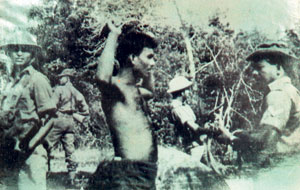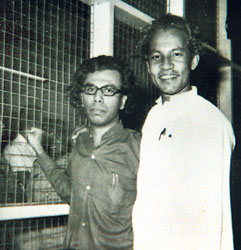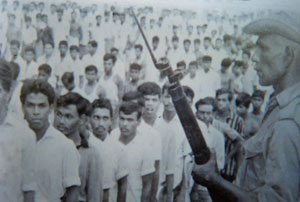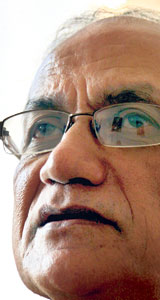Under cover of darkness, three young men travelled by taxi to the bo-tree junction at Borella. While two stood at the bus-stand, one walked into the Ritz cinema, found several of their sahodarayas (comrades) watching a movie, came back and whispered that it was not time yet.
The three, with one gripping a heavy suitcase, waited. They waited in vain………..for their leader didn't turn up. They waited for one and a half hours and noticed that both vehicular traffic and pedestrians had thinned out. Curfew had been declared.
It was the night of April 5, 1971.
The diminutive but bold youth who was holding onto the suitcase then walked up to a Sub-Inspector of Police who was on the Borella roundabout and requested that he please stop a taxi for them to get home. The SI obliged and they were back in their boarding-house at Kotahena, mission unaccomplished.
At the crack of dawn, around 2.30 a.m. the next day soldiers and police struck, storming the boarding-house and not only taking into custody the three youth but everyone else as well.
It was later, much later that they got to know that their mission was to commandeer a vehicle at Borella and proceed to the Rosmead Place residence of then Prime Minister, Sirimavo Bandaranaike, and take her into custody, while across the country bands of youth would storm police stations. This was to establish the "kotang anduwa" that more than 10,000 youth hoped would bring about equality, justice and fairplay. (The name 'kotang anduwa’ came from the fact that the young revolutionaries were supposed to cut down trees and remove lamp-posts and telephone-posts to be used as roadblocks to hinder the movement of the army and the police.)
The young man, 28 then, waiting in vain while gripping the suitcase stuffed with grenades at Borella, while his sahodarayas were armed with revolvers, was none other than Somawansa Amarasinghe.
"I was expected to drive the vehicle that we would commandeer, to Rosmead Place," recalls Somawansa.
The one-day revolution dubbed the 'Aprel kerella' (April insurrection), the Janatha Vimukthi Peramuna (JVP) had planned and plotted had failed even before it started on April 5. For, the mission leader who was tasked with the vital arrest of the PM had himself been taken into custody by the police several hours earlier.
 |
| The failed insurrection: A JVP suspect arrested by the armed forces. Pix courtesy the JVP |
The tip off had been by a police agent, a relative of then JVP Second-in-Command, Nimalasiri Jayasinghe, who had assumed the nom de guerre 'Loku Athula'.
Somawansa, currently Leader of the JVP -- which has four Members in Parliament under the symbol of the Democratic National Alliance -- was to come into prominence as a Member of the Politburo in the JVP's second bloodier and more brutal uprising of 1987-89. He was the only Politburo Member to escape death by leaving the country in the late 1980s.
In 1971, however, Somawansa was only a minor cog in the JVP wheel, under the mentorship of "cell leader" Piyasiri Bandara whom he would meet at the Sangharamaya of the Vidyodaya campus at Gangodawila.
I came face-to-face with Comrade Rohana Wijeweera, "very briefly" in 1975 at the Welikada Prison, four years after the insurrection failed, says Somawansa, adding that he had got a glimpse of the JVP Leader when he addressed a huge rally at Hyde Park in August 1970. That day all roads to Hyde Park were blocked with a mass of humanity surging towards the meeting, he says.
The youngest in a family of seven children, Somawansa was born in Payagala, schooled firstly at Kalutara Balika Vidayala and later at Kalutara Vidyalaya until his H.S.C. He was not only first in class from Form 1, good in Maths, but also with heavy leanings towards fields as diverse as music and cricket (he set the bowling record for his school).
From his childhood, he had had a close affinity with the temple near his humble home, the Sumanaramaya - coming under the influence of the High Priest, Ven. Kalamulle Sugathadheera, in fact himself wanting to don saffron robes and follow in the footsteps of Lord Buddha. He also read a variety of books available at the temple which encompassed Literature, Politics and biographies of people such as Mahatma Gandhi.
When Maha Kavi Ananda Rajakaruna launched a fast at the temple, demanding that priority should be given to Swabhasha (both Sinhala and Tamil, Somawansa hastens to add), it was he as a 10-year-old who was given the responsibility of looking after the poet and serving water to him.
"These were people who were willing to give up their lives for the rights of others," says Somawansa.
It was also at the temple that he came into contact with many leftist politicians.
As a senior student, Somawansa's rebellious streak came out when he wore National Dress instead of the European trousers and shirt, against severe admonishments and threats of expulsion by the Principal.
Later Somawansa joined the Irrigation Department's Training School at Galgamuwa, close to Anuradhapura as a "Learner".
 |
| JVP leader Rohana Wijeweera (L) and Prins Gunasekara (R) at the Criminal Justice Commission (located in Thunmulla ) after the 1971 uprising. Pix courtesy the JVP |
After passing out and serving as an Irrigation Technical Officer in different parts of the country, it was while he was working at the Hydraulics Research Branch at Jawatte Road that he was attracted to the ideology being promoted by Comrade Wijeweera. However, the JVP was not interested in young men who were working, focusing its sights mainly on undergraduates and unemployed youth, he says.
"We sought out the JVP," says Somawansa who finally got a link through a friend and joined political discussions in the evenings going into the dead of night at the trade union office of the Land Development Department behind Devi Balika Vidyalaya. It was here that he followed the Panthi Paha (Five Classes) which gave the interpretation of Marxism being spread by Wijeweera and his 'Inner Circle' who also believed that a small group could bring about a revolution. They were inspired by the revolutionary ideals of Che Guevara from Argentina who supported Fidel Castro's Cuban revolution.
The Five Classes dealt with the 'economic crisis' -- the problems facing the peasant farmer and the rural worker; 'Independence' -- giving a historical background to the ill-effects of colonial rule; 'Indian expansionism' -- how Indian capitalists were attempting to spread their tentacles into smaller countries; the Left movement -- drawing lessons from the failure of the Old Left to make any serious impact on local politics; and 'the path the Revolution should take'.
By this time, personally Somawansa had come up slightly in life, getting a loan to buy a brand new motorcycle. "It was a black Honda 125," recalls Somawansa, rare on the roads those days. He had paid a princely sum of Rs. 4,000, securing a loan although his salary at that time was Rs. 300 odd.
Without hesitation he gives the no. 5 Sri 6022, for it was the mo-bike which paved entry into the JVP for Somawansa but ultimately also put the Criminal Investigations Department (CID) on his trail.
To test me, whether I was an infiltrator, the JVP wanted me to give my bike to them, says Somawansa, who did just that. His initiation to the JVP came in 1969. But "I was on the periphery not really inside", he concedes.
The 'Inner Circle' of 1971 headed by Wijeweera consisted of 13 members and included Wijesena Vitharana alias Sanath, a teacher from Kalattawa, 'Karu' or W. T. Karunaratne from the Inland Revenue Department, Nimalasiri Jayasinghe alias 'Loku Athula' and Piyatileke Samararatne alias 'Machang'.
By April 1971, however, much water had flowed under the bridge, for while Wijeweera was on his way to Ampara on March 13, a special police team had arrested him for the second time and taken him to the Jaffna jail.
By March 16, the government had declared a state of Emergency under which wide powers including the authority to dispose of bodies without postmortems being conducted were given to the police and the armed forces, says Somawansa
 |
| A rehabilitation camp for JVP suspects. Pic courtesy the JVP |
Explaining that after the Hyde Park meeting the government had sensed the red signals and police repression had begun, Somawansa says that on April 2, 1971, his motorcycle had been taken into custody while being used for the transport of posters. The same day CID sleuths visited his home at Payagala.
He, however, was not there. Soon after, a neighbour had rushed from Payagala to his sister's home in Maradana to warn him that the CID was looking for him. It was then that he made his way to Vidyodaya to meet his cell leader who took him to the Kotahena boarding-house.
Assigned the mission, but not told exactly what it was, that the three young men on April 5 returned from Borella to Kotahena. Arrested at dawn on April 6, Somawansa along with the others was taken to the Maradana Police, to be beaten up mercilessly for a day. Later transferred to the infamous 4th Floor of the CID, numerous torture methods including the "thakkali" treatment had been tried out on him. Do you know what "thakkali" is, he smiles, and goes on to explain that the victim is made to lie down on his front either on the floor or a bench and systematically battered on the buttocks with batons, until they become as squashy as a tomato.
The agony was unbearable, he says, adding that he thought he would die. It was 14 days later that he was taken to the Welikada Prison and kept in isolation, in-communicado, for a long while, like all the other JVP members who were incarcerated and later tried by the Criminal Justice Commission. The Jailed JVP members were released in the late 1970s
Somawansa who became a Politburo Member in 1984, assumed the Leadership of the JVP in 1990, as Wijeweera had been killed in November 1989. He returned to Sri Lanka in 2001 and came back for good in 2004.
The rest is history. |





